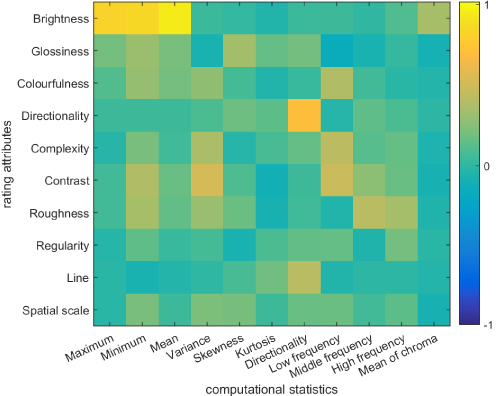References
1DongY.2019Deep appearance modeling: a surveyVis. Inform.3596859–6810.1016/j.visinf.2019.07.003
2DanaK.van GinnekenB.NayarS.KoenderinkJ.1999Reflectance and texture of real-world surfacesACM Trans. Graph.181341–3410.1145/300776.300778
3FilipJ.LukavskyJ.DechterenkoF.FlemingR.SchmidtF.
4FlemingR. W.2014Visual perception of materials and their propertiesVis. Res.94627562–7510.1016/j.visres.2013.11.004
5TamuraH.MoriS.YamawakiT.1978Textural features corresponding to visual perception, systems, man and cyberneticsIEEE Trans.8460473460–7310.1109/TSMC.1978.4309999
6Ravishankar RaoA.LohseG.1996Towards a texture naming system: identifying relevant dimensions of textureVis. Res.36164916691649–6910.1016/00426989(95)00202-2
7HeapsC.HandelS.1999Similarity and features of natural texturesJ. Exp. Psychol. Hum. Percept. Perform.25299320299–32010.1037/0096-1523.25.2.299
8MojsilovicA.KovacevicJ.KallD.SafranekR.Kicha GanapathyS.2000The vocabulary and grammar of color patternsIEEE Trans. Image Process.9417431417–3110.1109/83.826779
9MalikJ.PeronaP.1990Preattentive texture discrimination with early vision mechanismsJ. Opt. Soc. Am. A7923932923–3210.1364/josaa.7.000923
10VanrellM.VitriaJ.RocaX.1997A multidimensional scaling approach to explore the behavior of a texture perception algorithmMach. Vis. Appl.9262271262–7110.1007/s001380050047
11FlemingR. W.WiebelC.GegenfurtnerK.2013Perceptual qualities and material classesJ. Vis.139:19:209:1–9:2010.1167/13.8.9
12TanakaM.HoriuchiT.2015Investigating perceptual qualities of static surface appearance using real materials and displayed imagesVis. Res.115246258246–5810.1016/j.visres.2014.11.016
13MartínR.IseringhausenJ.WeinmannM.HullinM. B.2015Multimodal perception of material propertiesProc. ACM SIGGRAPH Symposium on Applied Perception, SAP ’15334033–40ACMNew York, NY10.1145/2804408.2804420
14FilipJ.KolafováM.2019Perceptual attributes analysis of real-world materialsACM Trans. Appl. Perception (TAP)161191–1910.1145/3301412
15SchwartzG.NishinoK.2013Visual material traits: Recognizing per-pixel material context2013 IEEE Int’l. Conf. on Computer Vision Workshops883890883–90IEEEPiscataway, NJ10.1109/ICCVW.2013.121
16SharanL.LiuC.RosenholtzR.AdelsonE. H.2013Recognizing materials using perceptually inspired featuresInt. J. Comp. Vis.103348371348–7110.1007/s11263-013-0609-0
17SchwartzG.NishinoK.2015Automatically discovering local visual material attributes2015 IEEE Conf. on Computer Vision and Pattern Recognition (CVPR)356535733565–73IEEEPiscataway, NJ10.1109/CVPR.2015.7298979
18FujisakiW.TokitaM.KariyaK.2015Perception of the material properties of wood based on vision, audition, and touchVis. Res.109185200185–20010.1016/j.visres.2014.11.020
19SharanL.RosenholtzR.AdelsonE. H.2014Accuracy and speed of material categorization in real-world imagesJ. Vis.1412:112:2412:1–12:2410.1167/14.9.12
20GigilashviliD.ThomasJ. B.PedersenM.HardebergJ. Y.2021On the appearance of objects and materials: qualitative analysis of experimental observationsJ. Int. Colour Assoc. (JAIC)27265526–55
21NordvikE.SchütteS.BromanN. O.2009People’s perceptions of the visual appearance of wood flooring: a kansei engineering approachForest Prod. J.59677467–7410.13073/0015-7473-59.11.67
22HayesA. F.KrippendorffK.2007Answering the call for a standard reliability measure for coding dataCommun. Methods Meas.1778977–8910.1080/19312450709336664
23PortillaJ.SimoncelliE. P.2000A parametric texture model based on joint statistics of complex wavelet coefficientsInt. J. Comp. Vis.40497049–7010.1023/A:1026553619983
24VacherJ.BriandT.2021The Portilla–Simoncelli texture model: towards understanding the early visual cortexImage Process. on Line11170211170–21110.5201/ipol.2021.324
25Hagh-ShenasH.InterranteV.Hee-ParkC.2006A closer look at texture metrics for visualizationProc. SPIE605760570@10.1117/12.643150
26MaskeyM.NewmanT. S.2021On measuring and employing texture directionality for image classificationPattern Anal. Appl.24164916651649–6510.1007/s10044-021-01013-8
27Van der MaatenL.HintonG.2008Visualizing data using t-SNEJ. Mach. Learn. Res.9257926052579–605
28FilipJ.VavraR.HaindlM.ZidP.KrupickaM.HavranV.2013BRDF slices: accurate adaptive anisotropic appearance acquisitionConf. on Computer Vision and Pattern Recognition, CVPR432143264321–6IEEEPiscataway, NJ10.1109/CVPR.2013.193
29FilipJ.ChantlerM.GreenP.HaindlM.2008A psychophysically validated metric for bidirectional texture data reductionACM Trans. Graph.27138:1138:11138:1–138:1110.1145/1457515.1409091

 Find this author on Google Scholar
Find this author on Google Scholar Find this author on PubMed
Find this author on PubMed
 Open access
Open access